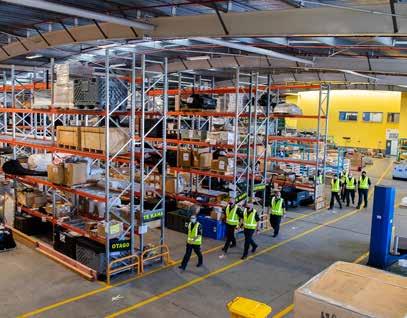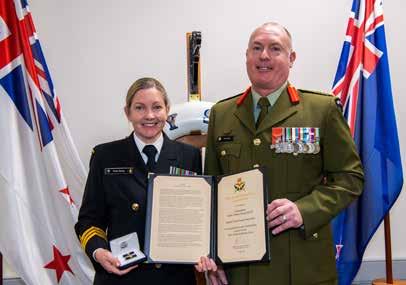
4 minute read
Naval Supply Depot
SUPPORTING MARITIME LOGISTICS
As part of an ongoing series on the Navy’s behind-the-scenes support organisations, Navy Today showcases the Defence Logistics Command (Maritime), Naval Supply Depot.
The Naval Supply Depot, a massive warehouse structure in the North Yard, is the biggest feature of the Navy’s Supply Chain Group, itself a sub-unit of Defence Logistics Command (Maritime). It’s responsible for delivering operational logistic support for all maritime platforms, HMNZS PHILOMEL (including satellite units) and to wider NZDF operations. In short, NSD provides materiel logistic support in order for maritime units and crews to operate effectively. In the Defence Force’s largest maritime warehouse, you’ll find most everything you’d need for a Fleet unit to operate, with inventory ranging from nuts, bolts, washers and O rings to ships engines and generators (lower and higher assemblies). You won’t find ammunition or munitions, small arm weapons and parts, rations (food), controlled pharmaceutical items, Defence clothing or bunked fuels. It’s easy to sense the pride in a team who keep the Navy running. It’s definitely evident in the voice of Lieutenant Commander Chris Smith, Deputy Supply Chain Manager, as he shows us around. But it’s also evident in the prominently-displayed Deputy Chief of Navy commendation on the wall in the NSD reception area. The Supply Chain Group has also had two Civilian of the Year Awards (Andrew Charnley 2020 and Shelley Newland 2021) and a New Zealand Defence Force commendation for the Supply Chain Manager / Fleet Maritime Logistics Officer, Commander Paula Dacey. Earlier this year, the SCG also received an ISO 9001: 2015 accreditation for operating a quality management system. The Naval Supply Depot has around 60 staff performing various duties within the Group, comprising both military and civilian personnel. While the civilian staff provide the continuity, Logistics Supply Specialists and Maritime Logistics Officers will rotate through as part of their trade training and career development. Goods are basically receipted in the warehouse and are either tracked to ships’ shelves, or a unit’s distribution bin or into the warehouse inventory holdings.
The inventory for an operational ship is complex enough, but the Group is also part of the Maritime Engineering Support Team (MEST). This incorporates Babcock New Zealand Limited, who are tasked with the maintenance, repair and overhaul of ships, equipment and systems. Their shopping list can be substantial. And it’s not just about replenishing ships alongside at Devonport. When the two Anzac frigates were in Canada, undergoing their Frigate Systems Upgrades, essential ship’s stores had to be packaged up and freighted over – not an easy task during the COVID pandemic. “COVID-related lockdowns and restrictions were a significant challenge for us in terms of the world supply chain issues,” says LTCDR Smith. “Everything went into lockdown. A large percentage of freight coming into and out of New Zealand by air was via passenger aircraft and when they ceased flying, the Defence Force was competing for the same space on the limited aircraft still flying as the rest of New Zealand industry. Fortunately, with the easing of restrictions and increase in freight movement globally, all that has eased now.”
The NSD is not like a DIY store. You can’t go to an aisle marked ‘Screws’. Everything that arrives is given a barcode, and the item is assigned to a set location in one of many sections, racks and shelves. If an item is needed, a computer search will provide the location code. Because of the size of the racking within the warehouse, many of the items are at height, but there’s a clever way to retrieve them. A specialised packer, rather like a forklift, is operated by a trained storesperson and is electronically guided by wire sensors installed in the warehouse floor. They can fit in the space between racks, placing or retrieving items sideways. And, like any warehouse, there’s the odd item being sheltered or being ‘Held on Behalf Of’ because there’s nowhere else for it to be adequately stored. In NSD’s case, there’s an entire Wasp helicopter, stored for the Navy Museum.
– LTCDR Smith.

The upstairs offices are humming, with Inventory Support, Customer Services and Material Data Management teams responding to enquiries and purchase orders. It’s not quite a 24/7 operation, although there is a duty NSD Officer on call outside of normal working hours for anything urgent. “The staff have been fantastic, especially in the past few years under COVID restrictions,” says LTCDR Smith. “Essential personnel still had to come onto base, working with limited resources to manage demands and maintain outputs, which also included support to Operation Protect. The demands of providing military personnel to Isolation Facilities, Northern and Southern Border checkpoints and wider Operation Protect HQ duties was a challenge for all, as those remaining at NSD were required to fill the gaps, while maintaining essential outputs. Our civilian staff were an excellent support as they allowed the military personnel to support the New Zealand Government’s direction. So when I see the commendation on the wall, and you can read in writing what we have all achieved, you think, yeah, we’ve done a lot. I’m very proud of the way the whole team has operated over this time.”


Second from top: Deputy Supply Chain Manager LTCDR Chris Smith. Below: Inventory Controller Shelley Newland. Bottom: CDR Paula Dacey receives an NZDF Commendation from Chief Joint Defence Services, BRIG Rob Krushka











